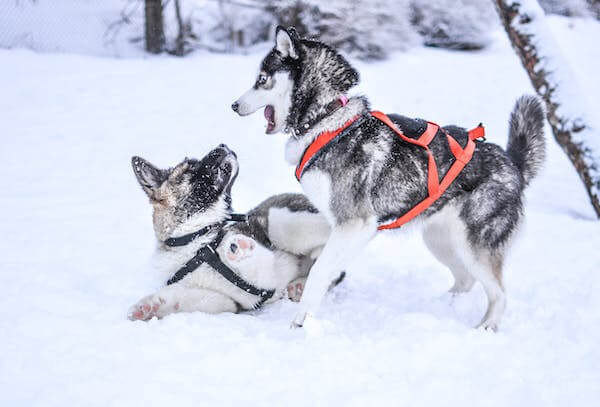Caring for your furry friend involves more than just providing food and shelter. Weather conditions can significantly impact your dog’s well-being, so it’s crucial to learn their needs. In this guide, we’ll explore the best practices for caring for your dogs in various weather conditions….from a dog mommy.
Navigating the Snowy Season
Walking in a Winter Wonderland:
When it comes to snowy weather, walking your dog can be an enjoyable experience if it’s done safely. Protect your puppy’s paws with booties to prevent the ice, snow and salt from causing irritation. Limit walks during the extreme cold, especially for smaller or short haired breeds.

Cozy and Warm Indoors:
Create a warm and comfortable indoor space for your dog during the colder months. Provide extra bedding, and consider investing in a dog sweater for added warmth. Be mindful of your dog’s tolerance to cold – some breeds handle it better than others.
Bathing in the Snow:
While it’s essential to keep your dog clean, I do not recommend baths in the winter. Cold weather can dry out your dog’s skin, so opt for dry shampoo or spot cleaning as needed. If your dog needs a bath in the winter make an appointment at your local groomer or do it yourself in the bathtub.
Shop Now
Healthy Pup Tips
Balanced Nutrition:
– Provide high-quality, age-appropriate dog food.
– Ensure a balanced diet with the right proportions of proteins, carbohydrates, fats, vitamins, and minerals.
– Consult your vet for personalized nutritional advice based on your puppy’s breed, size, and age.
Regular Exercise:
– Engage in daily walks, play sessions, and interactive games to keep your pup physically active.
– Adjust exercise routines based on your dog’s age, breed, and health condition.
– Mental stimulation is as crucial as physical activity – consider puzzle toys and training sessions.
Routine Veterinary Care:
– Schedule regular check-ups with the veterinarian for vaccinations, preventive care, and health assessments.
– Stay updated on parasite control, including flea and tick prevention.
– Discuss spaying/neutering options and dental care with your vet.
Hygiene and Grooming:
– Brush your pup’s coat regularly to prevent matting and reduce shedding.
– Clean ears, trim nails, and brush teeth to maintain overall hygiene.
– Bathe your pup as needed, using dog-friendly shampoos and conditioners.
Proper Identification and Microchipping:
– Ensure your pup wears a collar with an ID tag containing your contact information.
– Consider microchipping as a permanent form of identification in case your pup gets lost.
Monitoring Health Signs:
– Be vigilant for signs of illness, discomfort, or behavioral changes.
– Address any concerns promptly and seek veterinary advice when needed.
– Maintain a record of your pup’s health history and share it with your vet during check-ups.
Provide a Safe and Comfortable Environment:
– Create a safe space for your pup, free from hazards and toxic substances.
– Ensure your home environment is suitable for your pup’s size and breed.

Happy Dogs!
Adopting your dog’s care routine to different weather conditions is key to their overall wellbeing. By following these tips you will create a happy and healthy environment for your furry friend. Remember dogs are unique so pay attention to their individual needs and adjust your routine accordingly.



